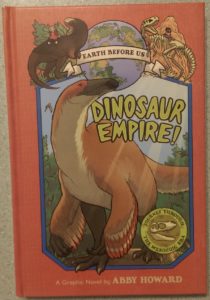Late Post, Good Reason
Namely, I was reading Abby Howard’s new graphic novel, Dinosaur Empire!¹. For those that are looking for a quick verdict: thumbs up. Waaaayyy up. Like, all the thumbs in the vicinity. If you in the near future hear about a vicious criminal attacking random people and hacking off their thumbs, it’s only because I need those thumbs to make them go up to indicate the degree to which this book is good.
Slightly longer version: Howard’s crafted a story around a broad topic (the entire history of dinosaurs and similar extinct critters which were not dinosaurs — spanning a range of 140 million years or so — without reducing it to bare facts. There’s a plot to it, as Ronnie (who scored a 0 on her fifth-grade dinosaurs quiz, and has until tomorrow to take it again or suffer a damaged academic future) learns (reluctantly at first, then with increasing interest) all about the evolution and extinction of archosaurs, sea reptiles, flying reptiles, mammals, plants, insects, and dinosaurs.
She’s disinterested at first — just skip ahead to the T rex, please! — but Ms Lernin wins her over. Ms Lernin is the eccentric (that means weirdo) former paleontologist that lives down the road (and who bears a striking resemblance to Howard herself) with a recycling bin that’s bigger on the inside and lets her travel to different points in time and space². By cycling through the various eras of the Mesozoic, Ronnie watches evolution in action and learns about ecological niches, convergent evolution, the phylogenetic tree, continental drift, global weather patterns, how large herbivores with armor probably means there’s large predators around, and feathers.
Glorious, colorful feathers, from early late Triassic protofeather fluff to fully–plumed nonavian dinosaurs of the late Cretaceous. We didn’t always know about warm-blooded feathered dinos, Ms Lernin tells us³, but that’s one of the joys of paleontology — we’re always figuring stuff out. There’s a joy of discovery that suffuses the entire book: new species to discover, new relationships to figure out, new behaviors to determine, and that fact that anything from cat-sized crocodylomorphs to the first snake can be considered cute (and in many cases, soft and fluffy).
The variety of creatures will engage readers of the target age group (and anybody that’s every been a member of the target age group, which let’s call 8-12 years old), and the repeated lessons told at each time period will subtly reinforce complex ideas. I’m not exaggerating when I say that this is probably the best introductory, full-breadth book for teaching kids about dinosaurs and dinosaur-like animals.
Now give me your thumbs.
Spam of the day:
Dear Coffee-Drinker #2324,
As a thank you for your years of loyalty to Starbucks, we’re giving you a coupon for 5 complimentary-cups of Starbucks Cofee(Venti-Sized Cups Only)
I don’t drink coffee.
_______________
¹ Which is listed as volume 1 of the Earth Before Us series, but I can’t find anything on the publisher’s page to indicate what the subsequent books in the series would be: topic, publication schedule, creative team, nada.
It appears that Ms Howard will have a Reddit AMA on Monday, 7 August at noon EDT. Maybe somebody can ask her?
² Asked how this is possible, she shrugs and says Let’s just call it Science Magic. Science Magic also keeps Ms Lernin and Ronnie from drowning, dying from falls, getting squished, or eaten (but still requires them to run from wasps). Hooray for Science Magic!
³ And she points out some desert-dwelling varieties lost the need for feathers even after they evolved.

The above comments are owned by whoever posted them. The staff of Fleen are not responsible for them in any way.